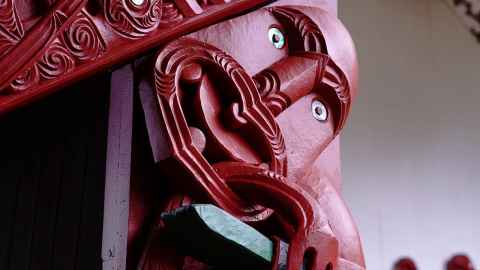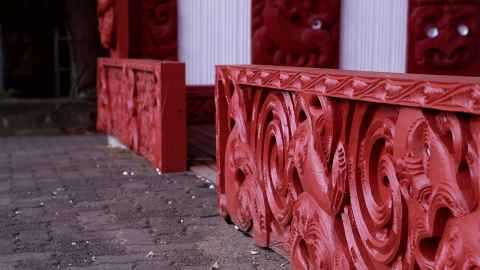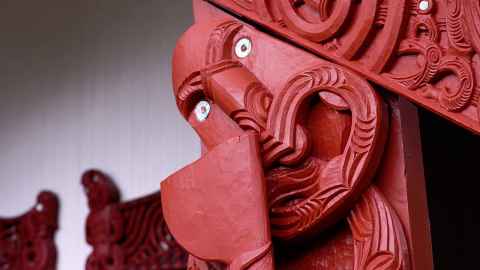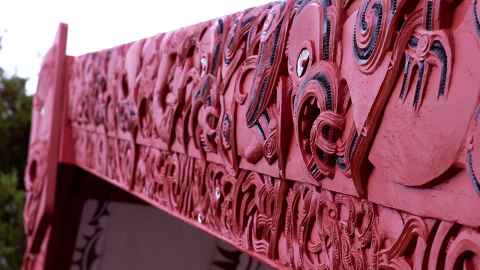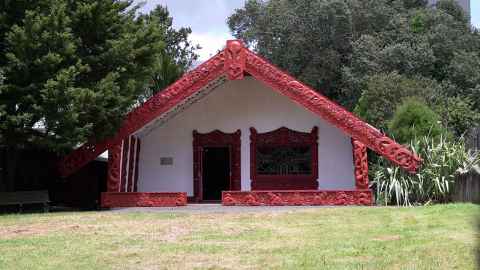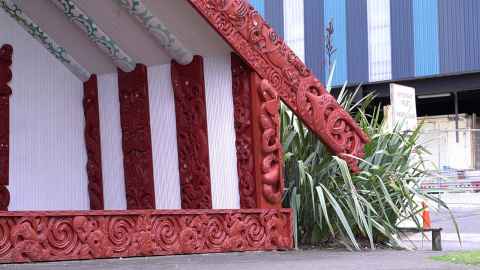Same, same but different: new whakairo at Waipapa Marae
8 February 2024
In honouring tradition, Waipapa Marae replaces old carvings with new, marking a symbolic renewal of heritage.
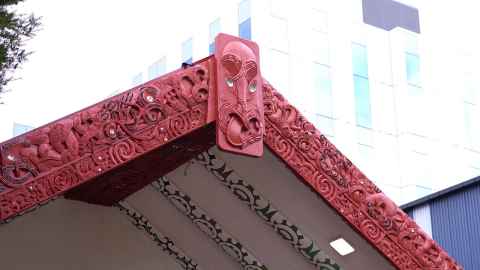
In a moving ceremony on 11 January, Waipapa Taumata Rau, University of Auckland paid tribute to the rich cultural heritage of the whakairo (carvings) at Waipapa Marae.
The weather-worn exterior whakairo, which had adorned the Marae since their installation in 1987, needed to be removed and buried before replacements could be installed.
The decision to bury the cherished carvings is rooted in the customs of Ngāti Whātua Ōrākei, the University’s iwi manaaki, and reflects the spiritual significance attributed to these cultural treasures.
Kaiarataki Michael Steedman, Deputy Pro Vice-Chancellor Māori, oversaw the ceremony which involved machinery to delicately lower the weighty taonga into specially prepared resting places. A karakia also took place around the marae ātea.
The original carvings were erected by Keith Walker. This time, both he and his son Daniel removed them and helped put the new ones in place.
The blessing ceremony featured Te Kohanga Reo o Hineteiwaiwa leading hīmene (hymns) and waiata. Tōia ki Waipapa students also played their part, with three helping in the nehunga (burial) of the whakairo.
The carvings are a symbolic representation of Tāne-nui-a-Rangi at the marae entrance, with the koruru at the apex symbolising his head and the maihi forming welcoming arms. They were crafted by the late tohunga whakairo, Dr Pakariki Harrison, QSO.
About the whakairo
Tohunga whakairo (master carver) Arekatera Maihi of Ngāti Whātua Ōrākei and Ngāpuhi descent, took on the responsibility of restoring the mauri of the old carvings, paying homage to their history.
“Whakairo require maintenance,” he says. “What generally happens over time is that the pieces deteriorate and rot."
The process took Maihi and his team at Toitū Design nine months to complete. They used kauri from Kaihu, Northland and stayed true to the original design.
However, Maihi made subtle additions to the amo (the short boards at the marae front), acknowledging the connection with the wāhi and tangata whenua, Ngāti Whātua Ōrākei.
The team also had to adopt unusual tactics to replicate the carvings.
“We used photography, including drone footage, to capture the designs. Usually we’d carve side by side but the marae was still operational which meant we couldn’t,” he says.
“It’s the first time we’ve done this and there was a lot of anxiety around getting it right – but we did the best we could.”
Reflecting on the restoration process, Maihi emphasises the importance of maintaining the integrity of the whakairo patterns.
“I didn’t want to change anything about an iconic marae.”
He says there's a narrative that connects the history of the University and the marae within the carvings, and the depiction of Tāne-nui-a-Rangi is a critical part of it.
(See full interview in the video above).
Tikanga
Māori tradition holds that in burying (or burning) old carvings, homage is paid to ancestors and the spiritual essence of the artefacts. Although Waipapa Marae does not have whakapapa ancestry, the burial process acknowledges the carvings' contribution to the University's legacy and connection to the past.
Symbolically, the process represents regeneration and renewal, embodying the Māori belief in the cyclical nature of life, death and rebirth. Māori culture attributes mana, or spiritual power, to various aspects, including carvings.
Therefore, burying preserves and protects the mana associated with the whakairo. Having the carvings buried at Waipapa ensures the continuity of cultural traditions and space for new whakairo to be created.
Media contact
Te Rina Triponel | Kaitohutohu Pāpāho Māori
E: te.rina.triponel@auckland.ac.nz
